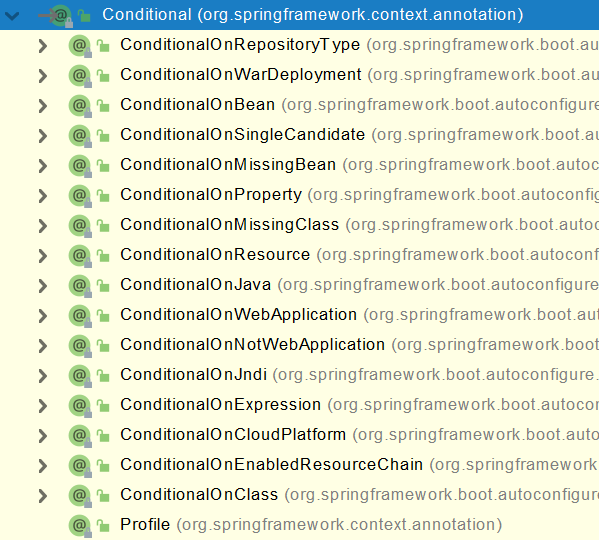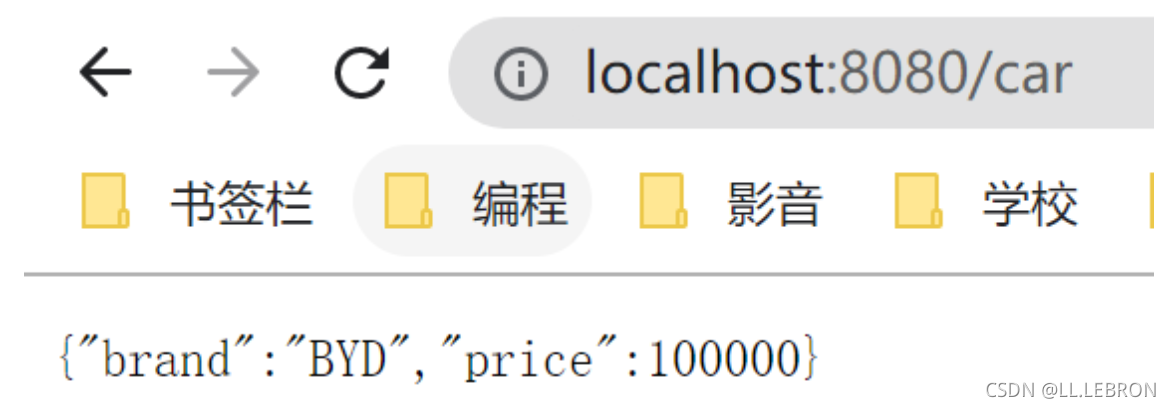1.组件添加
1.1@Configuration
@Configuration:告诉SpringBoot这是一个配置类
配置类里面使用@Bean标注在方法上给容器注册组件,默认也是单实例的
配置类本身也是组件
proxyBeanMethods:代理bean的方法
-
Full(
proxyBeanMethods = true):保证每个@Bean方法被调用多少次返回的组件都是单实例的 -
Lite(
proxyBeanMethods = false):每个@Bean方法被调用多少次返回的组件都是新创建的 - 组件依赖必须使用Full模式默认。其他默认是否Lite模式
最佳实战:
1.配置类组件之间无依赖关系用Lite模式加速容器启动过程,减少判断
2.配置类组件之间有依赖关系,方法会被调用得到之前单实例组件,用Full模式
代码实战演示:
|
1
2
3
4
5
6
7
8
9
10
11
12
13
14
15
|
@Configuration(proxyBeanMethods = false)//告诉SpringBoot这是一个配置类=配置文件public class MyConfig { @Bean//给容器中添加组件。以方法名作为组件的id。返回类型就是组件类型。返回的值,就是组件在容器中的实例 public User user01() { User zhangsan = new User("zhangsan", 18); return zhangsan; } @Bean("tom")//也可以自己设置id代替方法名作为id public Pet tomcatPet() { return new Pet("tomcat"); }} |
|
1
2
3
4
5
6
7
8
9
10
11
12
13
14
15
16
17
|
@SpringBootApplicationpublic class Boot01HelloworldApplication { public static void main(String[] args) { ConfigurableApplicationContext run = SpringApplication.run(Boot01HelloworldApplication.class, args); MyConfig bean = run.getBean(MyConfig.class); System.out.println(bean);//com.atguigu.boot.config.MyConfig@d67d8 //如果@Configuration(proxyBeanMethods = true)代理对象调用方法。SpringBoot总会检查这个组件是否在容器中有。 //保持组件单实例 User user = bean.user01(); User user1 = bean.user01(); //(proxyBeanMethods = true)返回true //(proxyBeanMethods = false)返回false System.out.println(user == user1); }} |
如果有组件依赖:
|
1
2
3
4
5
6
7
8
9
10
11
12
13
14
15
16
|
@Configuration(proxyBeanMethods = true)//告诉SpringBoot这是一个配置类=配置文件public class MyConfig { @Bean//给容器中添加组件。以方法名作为组件的id。返回类型就是组件类型。返回的值,就是组件在容器中的实例 public User user01() { User zhangsan = new User("zhangsan", 18); //user组件依赖了Pet组件 zhangsan.setPet(tomcatPet()); return zhangsan; } @Bean("tom")//也可以自己设置id代替方法名作为id public Pet tomcatPet() { return new Pet("tomcat"); }} |
|
1
2
3
4
5
6
7
8
9
10
11
12
13
14
15
|
@SpringBootApplicationpublic class Boot01HelloworldApplication { public static void main(String[] args) { ConfigurableApplicationContext run = SpringApplication.run(Boot01HelloworldApplication.class, args); MyConfig bean = run.getBean(MyConfig.class); System.out.println(bean); User user01 = run.getBean("user01", User.class); Pet tom = run.getBean("tom", Pet.class); //(proxyBeanMethods = true)返回(用户的宠物:true) //(proxyBeanMethods = false)返回(用户的宠物:false) System.out.println("用户的宠物:"+(user01.getPet() == tom)); }} |
1.2@Import
@Import:给容器中导入组件
代码演示:
|
1
2
3
4
5
|
//给容器中自动无参构造创建出这两个类型的组件、默认组件的名字就是全类名@Import({User.class, DBHelper.class})@Configuration(proxyBeanMethods = false) //告诉SpringBoot这是一个配置类 == 配置文件public class MyConfig {} |
|
1
2
3
4
5
6
7
8
9
10
11
12
13
14
|
@SpringBootApplicationpublic class Boot01HelloworldApplication { public static void main(String[] args) { ConfigurableApplicationContext run = SpringApplication.run(Boot01HelloworldApplication.class, args); //获取组件 String[] beanNamesForType = run.getBeanNamesForType(User.class); for (String s : beanNamesForType) { System.out.println(s); } DBHelper bean = run.getBean(DBHelper.class); System.out.println(bean); }} |
//输出:
com.atguigu.boot.bean.User
ch.qos.logback.core.db.DBHelper@16ef799
1.3@Conditional
@Conditional:条件装配,满足Conditional指定的条件,则进行组件注入
有一系列派生注解:

2.原生配置文件引入
2.1@ImportResource
原生xml文件:
|
1
2
3
4
5
6
7
8
9
10
11
12
13
|
<?xml version="1.0" encoding="UTF-8"?><beans xmlns="http://www.springframework.org/schema/beans" xmlns:xsi="http://www.w3.org/2001/XMLSchema-instance" xmlns:context="http://www.springframework.org/schema/context" xsi:schemaLocation="http://www.springframework.org/schema/beans http://www.springframework.org/schema/beans/spring-beans.xsd http://www.springframework.org/schema/context <a href="https://www.springframework.org/schema/context/spring-context.xsd">" rel="external nofollow">https://www.springframework.org/schema/context/spring-context.xsd"></a> <bean id="haha" class="com.atguigu.boot.bean.User"> <property name="name" value="zhangsan"></property> <property name="age" value="18"></property> </bean> <bean id="hehe" class="com.atguigu.boot.bean.Pet"> <property name="name" value="tomcat"></property> </bean></beans> |
自定义配置类:
|
1
2
3
4
|
@Configuration(proxyBeanMethods = true)//告诉SpringBoot这是一个配置类=配置文件@ImportResource("classpath:beans.xml")public class MyConfig {} |
测试:
|
1
2
3
4
5
6
7
8
9
10
11
12
|
@SpringBootApplicationpublic class Boot01HelloworldApplication { public static void main(String[] args) { ConfigurableApplicationContext run = SpringApplication.run(Boot01HelloworldApplication.class, args); boolean haha = run.containsBean("haha"); boolean hehe = run.containsBean("hehe"); System.out.println(haha);//true System.out.println(hehe);//true }} |
3.配置绑定
如何使用Java读取到properties文件中的内容,并且把它封装到JavaBean中,以供随时使用;
原生方法(配置文件复杂就显得麻烦):
|
1
2
3
4
5
6
7
8
9
10
11
12
13
|
public class getProperties { public static void main(String[] args) throws FileNotFoundException, IOException { Properties pps = new Properties(); pps.load(new FileInputStream("a.properties")); Enumeration enum1 = pps.propertyNames();//得到配置文件的名字 while(enum1.hasMoreElements()) { String strKey = (String) enum1.nextElement(); String strValue = pps.getProperty(strKey); System.out.println(strKey + "=" + strValue); //封装到JavaBean。 } } } |
3.1@ConfigurationProperties
配置文件:
mycar.brand=BYD
mycar.price=100000
创建一个car类:
|
1
2
3
4
5
6
7
8
9
10
11
12
|
//只有在容器中的组件,才会拥有SpringBoot提供的强大功能@Component@ConfigurationProperties(prefix = "mycar")//Lombok注解简化开发@Data@NoArgsConstructor@ToString@AllArgsConstructorpublic class Car { private String brand; private Integer price;} |
测试方法:
|
1
2
3
4
5
6
7
8
9
|
@RestControllerpublic class HelloController { @Autowired Car car; @RequestMapping("/car") public Car car(){ return car; }} |
测试结果:

3.2@EnableConfigurationProperties + @ConfigurationProperties
@EnableConfigurationProperties必须在配置类里写:
|
1
2
3
4
5
6
|
@Configuration(proxyBeanMethods = true)//告诉SpringBoot这是一个配置类=配置文件@EnableConfigurationProperties(Car.class)//1.开启Car属性配置绑定功能//2.把Car这个组件自动注册到容器中public class MyConfig {} |
该写法就不用在写@Component
|
1
2
3
4
5
6
7
8
9
|
@ConfigurationProperties(prefix = "mycar")@Data@NoArgsConstructor@ToString@AllArgsConstructorpublic class Car { private String brand; private Integer price;} |
以上就是学习SpringBoot容器功能及注解原理的详细内容,更多关于SpringBoot容器功能及注解的资料请关注服务器之家其它相关文章!
原文链接:https://blog.csdn.net/qq_45966440/article/details/120412878













